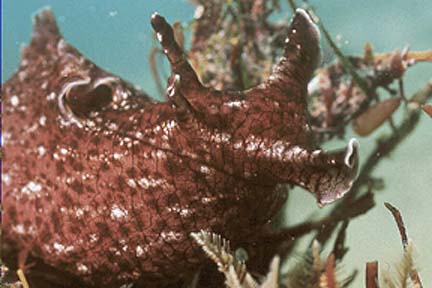
Ease of First Open-Water Dive Brings Amazement
By Lora Wray Photo by Mark Ruth
While underwater, my scuba diving instructor gently picked up a ten-inch purple blob of a creature, pulled the breathing regulator from his mouth and kissed the slimy thing! I witnessed this action in amazement, as I experienced my first open-water dive at age 35: stunned first that such a creature existed (it was a sea hare), that anyone would smooch such an animal, and then that a diver would remove their regulator (air source) while underwater. I sure had a lot to learn.
|
|
|
|
Our dive location was Monterey Bay, Calif., where visibility can often be pea-soup murky. On this fine day, visibility was down to 15 feet, due to a pelting rain the day before. As a novice with only a few pool dives under my weight belt, I grew concerned at how quickly my instructor-buddy disappeared into this dense soup, as he made a short swim to the bottom to retrieve a dropped spare weight.
The extra two-pound weight was for me, in case I needed it to prevent me from bobbing like a cork in my new ultra-buoyant wetsuit. Monterey's waters range from a cool 49-55 degrees F, so I had three layers of 1/4-inch wetsuit on my torso to block the cold. A 35-pound air tank and 16 pounds of lead weren't enough to get me under and keep me there (I weigh all of 115 pounds.) So, Mark, my instructor, attached the extra weight to my belt and down I went, with a helpful tug on my leg from below.
Building trust in and comfort with my scuba equipment took priority over exploring the nearby animal-rich rocks and undulating kelp. Mark, in instructor status for 10 years, made my goal for the dive a pleasant one -- relax and enjoy the scenery, with a few easy exercises thrown in. A nice start for a bookworm expanding her boundaries.
My buddy in life, as well as in diving, Mark and I held hands as we coasted a few inches above the light, sandy bottom of the bay, my eyes open wide (I wasn't watching for Great Whites . . . nope, not me.) He monitored my buoyancy and made helpful adjustments from time to time. He later told me that it takes between 20-30 dives for most people to get a good feel for their buoyancy, if they're paying attention to fine-tuning it.
I watched my instructor in peaceful delight (the cold didn't matter), as he spotted creature after creature and pointed them out to me. I enjoyed each small, plain fish to the most unusual balloon-like critters, like the sea hare he had loved on earlier. I took great delight in the tiny turbos (like one-inch flounders) that would scoot away from my exploring fingers, as if propelled by turbojets.
I was happy to feel clear progress in my basic skills on this first open-water dive. I dropped below the surface comfortably, confident that I'd be able to breathe freely and regularly. I compensated for the increased pressure in my ears, as soon as I felt it. I cleared the little bit of water that entered my mask by exhaling through my nose, looking up and lifting the bottom edge of the mask at the same time. I relaxed, and then relaxed more deeply, following excellent advice to do so at all times.
Pool diving more difficult than open water
I was surprised to learn that diving in a pool is more of a struggle than diving in deep water. A pool's shallowness makes it difficult to maintain good buoyancy control. How I struggled with my fly-away feet in those big, clumsy fins in my friend's eight-foot deep pool.
In contrast, while just 15 feet under the surf in the bay, I wriggled smoothly along with the fish, riding the currents and quickly appreciating the extra power and control the fins gave me.
We practiced a rough-water entry, which meant walking backwards into the water. This would be tricky with no gear on, but fully suited up with a tank, weight-belt and fins on, dodging rocks in swirling sand and churning water, it probably took five full minutes to do.
Once out past the outcroppings and small waves, I was told to simply rest completely on my back and regain my strength. It was an instruction I followed with pleasure. Diving in Monterey offers much to please the senses - vivid blue skies, Crayola-colored kayaks, impish harbor seals, sun-dappled kelp forests. Also, a lot of student divers take lessons there.
A novice even to snorkeling and ocean swimming, I reminded my instructor that every step of today's small adventure was foreign to me. I also had a foot-long snorkel attached to my head, but had yet to use it much and gain confidence in breathing through it. It was far easier to drink the bay through it like a straw. But I met all my goals that day, and was grateful to learn that I have some natural ability and calm about the whole concept of diving.
With Mark's 17 years of diving experiences, I was able to benefit from his "silent" nature lessons, as well as move toward certification, on my first open-water dive.
Near the end of the experience, we paused over a patch of sand that had dozens of tiny crescent-shaped ridges jutting upward. He gently swept his hand back and forth over the area, revealing about 50 small lavender-shelled olive snails. To my perception, it was as if he could see through the sand! How soon would I learn these "tricks" and be the experienced diver with a novice at my side?
Copyright © 1997-2023 Lora Wray, All rights reserved, reprinted by permission
Photograph Copyright 1997 Mark Ruth, all rights reserved, reprinted by permission